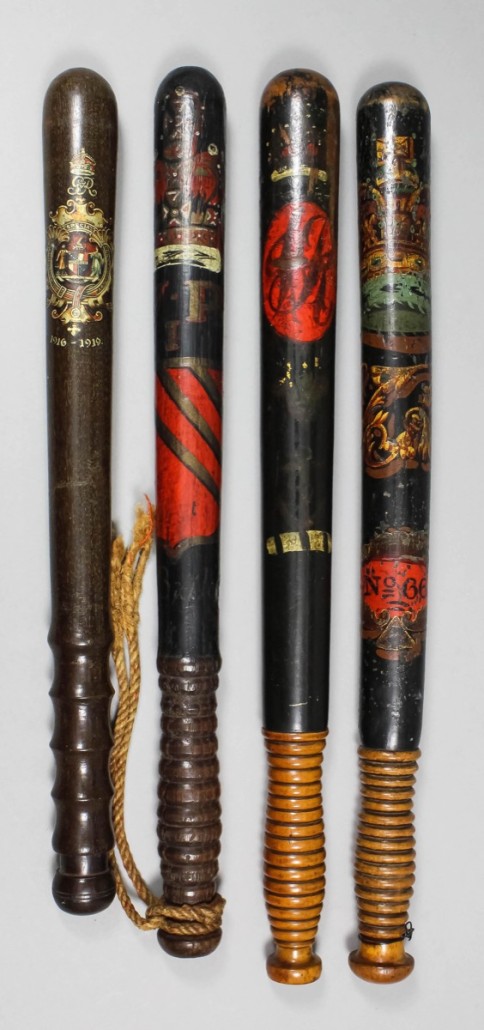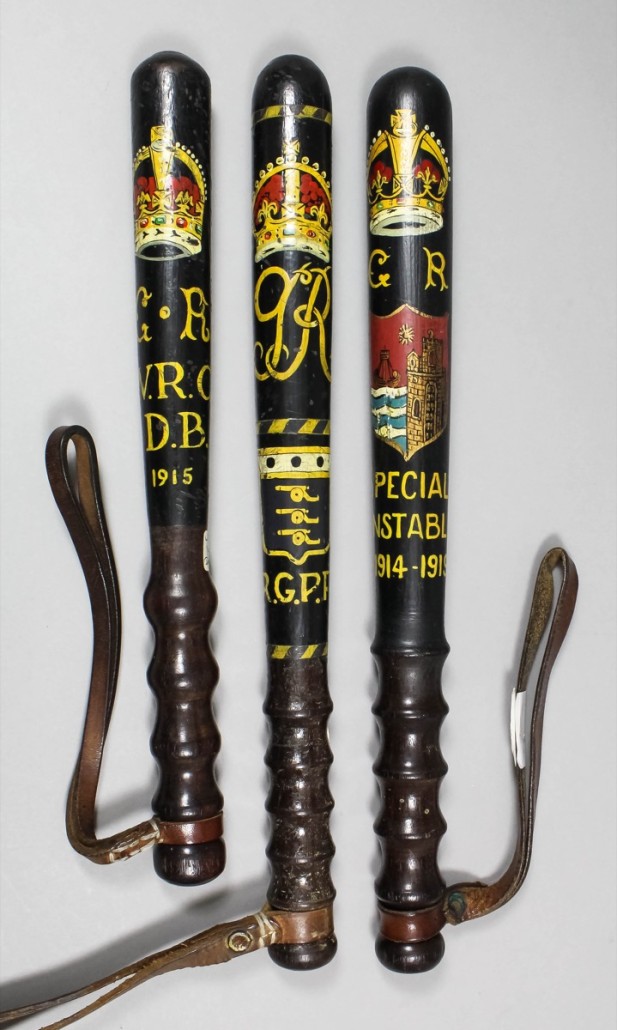
LONDON – I’m not sure where, but somewhere in the house is my late uncle’s truncheon. He was a special constable and, sadly, he died before I met him. From him, I inherited a love of fishing and a fascination with the unusual.
The rare truncheons and their even rarer predecessors, the tipstaves, pictured here, would have enthralled him. If he was still around he would probably have been among the bidders when they were sold this week.
Interestingly, they were collected by a man who discovered the attraction of antique police truncheons quite by chance. He was a bank official who was asked by one of his clients to act as the executor of his will. In time, when the will was proved, he discovered one of them had been left to him. The unexpected gift was the spark that ignited a passion and he spent 10 years of his retirement collecting more.
Their appeal is easy to understand. Aside from being historically important survivors from the early days of policing, they are colorful, often quirky objects with a beauty that belie their real purpose – that of subduing ne’er-do-wells and affording the officer carrying them a means of self-preservation.

Someone will correct me if I’m wrong, but I believe the tipstave has a history that predates the truncheon. Before the formation of the police force in 1829, the tipstaff, as the official carrying what in effect was a scepter of office, was a called, was a private citizen appointed by magistrates or a parish council to enforce the law and apprehend criminals.
While it might well have served as a means of self-defense, the main purpose of the tipstave was to prove the individual carrying it had a right to the office and to assist him in serving a warrant for arrest or seizure of property.
Made in silver or brass and often with a wooden handle, the tipstave was therefore made to look official by the addition of a crown of the reigning monarch at the business end. In some cases this unscrewed to reveal a hollow chamber in which the paper warrant could be concealed and kept safe prior to it being served.

London’s first professional policemen, the Bow Street Runners, founded in 1749 by Westminster magistrate Henry Fielding, served writs and arrested criminals and would have carried tipstaves and truncheons, but the former were superseded in 1829, when a Bill introduced by Sir Robert Peel, the Home Secretary in Lord Liverpool’s Tory Cabinet, established the Metropolitan Police Force.
Nicknamed “bobbies” and “peelers,” both after the founder, they numbered some 3,000 men, divided into small 20-mile circumference beats that were patrolled regularly to prevent crime rather than just apprehend criminals. The policy proved highly successful in reducing street crime and by 1857 every town and county was obliged to create its own police force.

Run on nonmilitary principles, simple, traditional equipment such as the helmet, notebook, light/dark lantern, handcuffs and a rattle (quickly replaced by a whistle) were employed rather than firearms. After a short transitional stage, the truncheon replaced the tipstave, the latter being carried by only inspectors and detectives until they were superceded in 1880 by the introduction of the warrant card.

The most collectible tipstaves are engraved with the name and dates of an officer’s service, and royal arms or the crest of the city, village or county where it had been in use, although these often turn out to have been for ceremonial or commemorative use.
Made from a variety of hardwoods such as lignum vitae, teak and ebony, although basic, the truncheon was a more practical weapon that could be used with one hand, leaving the other free to apprehend the criminal. A musket, on the other hand needed both hands and could put a policeman at risk if the firearm were to fall into the hands of the suspect.

However, the early fashion adopted by many forces for painted truncheons came in for some contempt, although what were once ridiculed as “painted rolling pins” are now highly sought after collectors’ items. Their decoration can assist in dating a truncheon and identifying which force and where in the country it was used.
The best are decorated with royal ciphers and town crests. A crown above an early 19th century date denotes a George III truncheon, while those with the initials “VR,” standing for Victoria Regina, are obviously Victorian. The initials “GR” could indicate a George V, early 20th century often commemorative piece.

Not all truncheons were used by policemen. One of my favorites, seen in an auction in 2011, was a rare early 19th century green-painted shopkeeper’s truncheon decorated in gilt with the figure of a woman seated at a spinning wheel, which was worded “As Dry As Dust, Pay You Must, for in this Shop There Is No Trust.” It sold for £360.
___
By CHRISTOPHER PROUDLOVE



